 From eighth Century Japan comes this image of a projection-space held at arm's length and a loaded brush at the ready.
From eighth Century Japan comes this image of a projection-space held at arm's length and a loaded brush at the ready. The first character is a movement across then down.
The first character is a movement across then down. The second mirrors the first: down and across.
The second mirrors the first: down and across. Together they form a new double character variously known as two-by-two; the prisoner and the guard; projection-space; self-grasping; dualism; self and other and so on. As a character that shows no sign of its cause and appears to know (echo) only itself, it is also sometimes translated simply as ignorance.
Together they form a new double character variously known as two-by-two; the prisoner and the guard; projection-space; self-grasping; dualism; self and other and so on. As a character that shows no sign of its cause and appears to know (echo) only itself, it is also sometimes translated simply as ignorance.The image above is a detail of a larger image in which a brightly garbed calligrapher looks at this character he has drawn.

 The journeyman projectionist is mounted on a galloping horse. Distracted from the uncontrolled rush of his charge, he faces backwards and looks at his projection-space with painted double. His vehicle, meanwhile, gallops on with its wild determined look.
The journeyman projectionist is mounted on a galloping horse. Distracted from the uncontrolled rush of his charge, he faces backwards and looks at his projection-space with painted double. His vehicle, meanwhile, gallops on with its wild determined look. Bound in the distinctive red harness of afflictive emotions, the horse is the untamed mind. Rider and vehicle alike: wild, divided, distracted and unstable.
Bound in the distinctive red harness of afflictive emotions, the horse is the untamed mind. Rider and vehicle alike: wild, divided, distracted and unstable. A white-robed bodhisattva looks with compassion at the horse and rider as they career by. He is diligent awareness, and carries a rope, symbol and reminder of interconnectedness. He offers the rope to the rider.
A white-robed bodhisattva looks with compassion at the horse and rider as they career by. He is diligent awareness, and carries a rope, symbol and reminder of interconnectedness. He offers the rope to the rider.Nirvana is mind turned inwardly, recognising its true nature."
Tulku Urgyen Rinpoche
Tulku Urgyen Rinpoche




